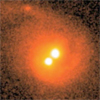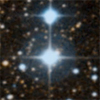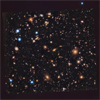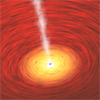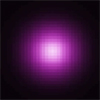CXC Home | Search | Help | Image Use Policy | Latest Images | Privacy | Accessibility | Glossary | Q&A
1. Learn About Black Holes
QuicktimeMPEG Audio Only
If a star has three times or more the mass of the sun and collapses, it can form a black hole.
These bizarre objects are found across the universe within double-star systems and at the centers of galaxies where giant black holes grow.
X-ray telescopes like Chandra can see superheated matter that is swirling toward the event horizon of a black hole.
Chandra has revealed how black holes impact their environments, how they behave, and their role in helping shape the evolution of the cosmos.
See black holes through Chandra's eyes.
[Runtime: 01:31]
(NASA/CXC/A. Hobart)
QuicktimeMPEG Audio Only
- Audio (481.5 kb)
If a star has three times or more the mass of the sun and collapses, it can form a black hole.
These bizarre objects are found across the universe within double-star systems and at the centers of galaxies where giant black holes grow.
X-ray telescopes like Chandra can see superheated matter that is swirling toward the event horizon of a black hole.
Chandra has revealed how black holes impact their environments, how they behave, and their role in helping shape the evolution of the cosmos.
See black holes through Chandra's eyes.
[Runtime: 01:31]
(NASA/CXC/A. Hobart)
2. Simulation of Black Hole Ejection
QuicktimeMPEG This simulation shows a collision between a pair of spiral galaxies leading to a merger between their supermassive black holes and an ejection of the new black hole that forms. This represents a model for the formation and evolution of the exotic X-ray source CID-42.
The galaxy collision causes long tails of stars to be thrown out of each galaxy. After the collision the two black holes (labelled by circles) initially located at the center of each galaxy orbit around each other until they eventually merge. The newly formed black hole recoils from the directional emission of gravitational waves produced by the collision, giving the newly merged black hole a sufficiently large kick for it to eventually escape from the galaxy. The simulation freezes briefly to make a comparison with the HST optical image, at a time about 6 million years after the merger. The speed of the black hole at this time is over three million miles per hour, compared to the escape velocity of the galaxy of only about 1.7 million miles per hour.
The masses of the two galaxies are about 450 billion and 230 billion times the mass of the sun, with stars forming throughout the simulation. The masses of the two black holes just before they merge are about 5.4 and 4.3 million times the mass of the sun, giving a total of about 10 million solar masses for the new black hole. Both black holes grow considerably during the galaxy collision. The total duration of the movie is 2 billion years, with the merger and ejection of the black hole occurring after 1.9 billion years. The movie runs at half speed after the merger so the eye can track the black hole flying out of the galaxy. The recoiling black hole could be detectable, by radiation from material in a surrounding disk, for several million years after the time of the observation. By the end of the simulation, the BH has virtually exhausted its gas supply and is moving, invisible, through intergalactic space.
[Runtime: 00.29]
(Laura Blecha)
Related Chandra Images:
QuicktimeMPEG This simulation shows a collision between a pair of spiral galaxies leading to a merger between their supermassive black holes and an ejection of the new black hole that forms. This represents a model for the formation and evolution of the exotic X-ray source CID-42.
The galaxy collision causes long tails of stars to be thrown out of each galaxy. After the collision the two black holes (labelled by circles) initially located at the center of each galaxy orbit around each other until they eventually merge. The newly formed black hole recoils from the directional emission of gravitational waves produced by the collision, giving the newly merged black hole a sufficiently large kick for it to eventually escape from the galaxy. The simulation freezes briefly to make a comparison with the HST optical image, at a time about 6 million years after the merger. The speed of the black hole at this time is over three million miles per hour, compared to the escape velocity of the galaxy of only about 1.7 million miles per hour.
The masses of the two galaxies are about 450 billion and 230 billion times the mass of the sun, with stars forming throughout the simulation. The masses of the two black holes just before they merge are about 5.4 and 4.3 million times the mass of the sun, giving a total of about 10 million solar masses for the new black hole. Both black holes grow considerably during the galaxy collision. The total duration of the movie is 2 billion years, with the merger and ejection of the black hole occurring after 1.9 billion years. The movie runs at half speed after the merger so the eye can track the black hole flying out of the galaxy. The recoiling black hole could be detectable, by radiation from material in a surrounding disk, for several million years after the time of the observation. By the end of the simulation, the BH has virtually exhausted its gas supply and is moving, invisible, through intergalactic space.
[Runtime: 00.29]
(Laura Blecha)
Related Chandra Images:
- Photo Album: CID-42
3. Zoom in to Cygnus X-1
QuicktimeMPEG Cygnus X-1 is located near large active regions of star formation in the Milky Way. Cygnus X-1 is a black hole about 15 times the mass of the Sun in orbit with a massive blue companion star. Astronomers used several telescopes including Chandra to study Cygnus X-1. The combined data have revealed the spin, mass, and distance of this black hole more precisely than ever before.
[Runtime: 00:30]
(NASA/CXC/A. Hobart)
Related Chandra Images:
QuicktimeMPEG Cygnus X-1 is located near large active regions of star formation in the Milky Way. Cygnus X-1 is a black hole about 15 times the mass of the Sun in orbit with a massive blue companion star. Astronomers used several telescopes including Chandra to study Cygnus X-1. The combined data have revealed the spin, mass, and distance of this black hole more precisely than ever before.
[Runtime: 00:30]
(NASA/CXC/A. Hobart)
Related Chandra Images:
- Photo Album: Cygnus X-1
4. Multi-wavelength Views of the Chandra Deep Field South
QuicktimeMPEG This sequence of images begins with a large optical image of the southern sky. The view zooms into the 4-million-second exposure of the Chandra Deep Field South, and then an optical and infrared image from the Hubble Space Telescope is overlaid. The Chandra sources are blue in this composite image. After further zooming in, yellow circles appear to mark the positions of very distant galaxies that existed when the Universe was less than about 950 million years old. The two small Chandra sources on the right show that all of the low and high energy X-rays that have been added up at the positions of these galaxies. This provides evidence that growing black holes have been detected in 30% to 100% of the distant galaxies.
[Runtime: 0.27]
(X-ray: NASA/CXC/U. Hawaii/E. Treister et al; Infrared: NASA/STScI/UC Santa Cruz/G. Illingworth et al; Optical: Wide-field: Akira Fujii; Close-up: NASA/STScI/S. Beckwith et al)
Related Chandra Images:
QuicktimeMPEG This sequence of images begins with a large optical image of the southern sky. The view zooms into the 4-million-second exposure of the Chandra Deep Field South, and then an optical and infrared image from the Hubble Space Telescope is overlaid. The Chandra sources are blue in this composite image. After further zooming in, yellow circles appear to mark the positions of very distant galaxies that existed when the Universe was less than about 950 million years old. The two small Chandra sources on the right show that all of the low and high energy X-rays that have been added up at the positions of these galaxies. This provides evidence that growing black holes have been detected in 30% to 100% of the distant galaxies.
[Runtime: 0.27]
(X-ray: NASA/CXC/U. Hawaii/E. Treister et al; Infrared: NASA/STScI/UC Santa Cruz/G. Illingworth et al; Optical: Wide-field: Akira Fujii; Close-up: NASA/STScI/S. Beckwith et al)
Related Chandra Images:
- Photo Album: Chandra Deep Field South
5. Animation of Hidden Baby Black Hole
QuicktimeMPEG This animation shows an artist's impression of a distant galaxy and its hidden black hole found in an epoch when the Universe was less than one billion years old. The galaxy contains regions of active star formation (blue) and large amounts of gas and dust (red). The view zooms into the galaxy, and a glowing disk of hot gas falling onto massive central object is seen. At the center of the disk is a supermassive black hole. Many types of radiation emitted from the disk are blocked by the veil of dust and gas, but very energetic X-rays are able to escape. Scientists found many of these black holes in the early Universe using the new Chandra Deep Field South.
[Runtime: 0.20]
View Stills
(NASA/CXC/A. Hobart)
Related Chandra Images:
QuicktimeMPEG This animation shows an artist's impression of a distant galaxy and its hidden black hole found in an epoch when the Universe was less than one billion years old. The galaxy contains regions of active star formation (blue) and large amounts of gas and dust (red). The view zooms into the galaxy, and a glowing disk of hot gas falling onto massive central object is seen. At the center of the disk is a supermassive black hole. Many types of radiation emitted from the disk are blocked by the veil of dust and gas, but very energetic X-rays are able to escape. Scientists found many of these black holes in the early Universe using the new Chandra Deep Field South.
[Runtime: 0.20]
View Stills
(NASA/CXC/A. Hobart)
Related Chandra Images:
- Photo Album: Chandra Deep Field South
6. GRS 1915's "Heartbeat" X-ray Variation
QuicktimeMPEG The heartbeat variation of GRS 1915 is shown here in a repeated cycle to emphasize the similarity between the X-ray light curve and an electrocardiogram. The period has been sped up by a factor of 40.
[Runtime: 0.20]
(NASA/CXC/Harvard/J.Neilsen et al)
Related Chandra Images:
QuicktimeMPEG The heartbeat variation of GRS 1915 is shown here in a repeated cycle to emphasize the similarity between the X-ray light curve and an electrocardiogram. The period has been sped up by a factor of 40.
[Runtime: 0.20]
(NASA/CXC/Harvard/J.Neilsen et al)
Related Chandra Images:
- Photo Album: GRS 1915+105



